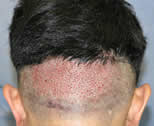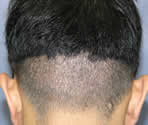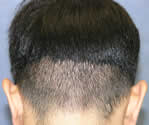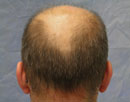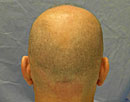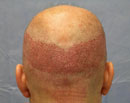|
||||||||
|
Follicular Unit Extraction (FUE) :
Follicular Unit Extraction (FUE) is a method of extracting, or “harvesting,” donor hair for transplantation in a follicular unit hair transplant. In an FUE procedure, an instrument is used to make a small, circular incision in the skin around a follicular unit, separating it from the surrounding tissue. The unit is then extracted (pulled) directly from the scalp, leaving a small open hole. This process is repeated until the hair transplant surgeon has harvested enough follicular units for the planned hair restoration. This process can take one or more hours and, in large sessions, may be accomplished over two consecutive days. The donor wounds, approximately 1-mm in size, completely heal over the course of seven to ten days, leaving tiny white scars buried in the hair in the back and sides of the scalp. This method of donor harvesting, removing follicular units one-by-one directly from the scalp, is what differentiates the FUE procedure from a traditional Follicular Unit Transplant (FUT), where the donor hair is removed from the scalp in one thin, long strip and then subsequently dissected into individual follicular units using a stereo-microscope. After the grafts are harvested, tiny “recipient sites” are made in the balding area of the scalp using a fine needle-point instrument. The follicular units are then placed into the recipient sites where they will grow into healthy hair-producing follicles. The creation of recipient sites and the placing of follicular unit grafts are essentially the same in both FUE and FUT procedures. The difference lies in the quality and quantity of grafts obtained with each technique. Instrumentation in Follicular Unit ExtractionFollicular Unit Extraction is an instrument-dependent procedure; therefore, the type of tool used for this procedure significantly affects its outcome. In fact, the development of increasingly better extraction instruments has closely paralleled advances in the procedure. Starting in 2011, Bernstein Medical – Center for Hair Restoration is offering Follicular Unit Extraction (FUE) hair transplants using the ARTAS robotic system, designed by Restoration Robotics, for the extraction of follicular unit grafts. You can read up on this advanced system for FUE by visiting the Robotics page in this section or the Robotics in FUE tag in the Hair Transplant Blog. Details about the different methods and instrumentation used in FUE can be found on the following pages: SAFE System, 3-step FUE, RotoCore, NeoGraft, Robotics, andRestoration Robotics. The Origin of FUEThe use of direct extraction to harvest follicular units was initially introduced by Dr. Woods in Australia as the “Woods Technique,” but he did not disclose the details of his procedure. The technique was first described in the medical literature by Rassman and Bernstein in their 2002 publication “Follicular Unit Extraction: Minimally Invasive Surgery for Hair Transplantation.” This paper provided the anatomic basis for the procedure, gave it its current name, and described the FOX test used to identify patient variability in harvesting, an issue which continues to be a significant challenge for doctors today. A major refinement in the procedure was advanced by Dr. Jim Harris by adding an additional step of blunt dissection to the technique, as this substantially reduced transection (damage) to follicles. FUE continues to evolve as more physicians learn about this procedure, gain experience with it in their practices, and offer improvements to the technique. Indications for FUEBecause FUE does not leave a linear scar, it may be appropriate for patients who want to wear their hair very short. It is also an advantage for those involved in very strenuous activities, such as professional athletes, who must resume these activities very soon after their procedure. The technique is also useful for those who have healed poorly from traditional strip harvesting or who have a very tight scalp. FUE also allows the surgeon to potentially remove hair from parts of the body other than the donor scalp, such as the beard or trunk, although there are many limitations with this process. Possibly the most straight-forward application of this technique is to camouflage a linear donor scar from a prior hair transplant procedure. In this technique, a small amount of hair is extracted from the area around a linear donor scar and then placed directly into it. Some patients desire FUE simply because they heard that FUE is less invasive than FUT or is non-surgical. The reality is that both procedures involve surgery and in both cases the depth of the incisions (i.e. into the fat layer right below the hair follicles) is the same. The difference is in the type of incision made. In FUE there are multiple round incisions scattered diffusely through the donor area and in FUT there is one single, long incision in the middle of the donor area. FUE should be chosen if the multiple round incisions are preferred and not because the technique is “non-surgical.” The Donor Area in FUEThe three photos below show the healing of a relatively small FUE procedure of 600 grafts. Note that in the photo on the right, the area where the grafts were taken from is visibly thinned. Click on the images for enlarged detail.
The photos below show the relatively large donor area needed for a FUE procedure of 1000 grafts. Note that in order to harvest the required number of grafts, some follicular units are removed from areas fairly close to areas of the scalp that may not be permanent. Click the images to view enlarged detail.
Post-op CourseSince FUE harvesting requires a much larger area compared to strip harvesting (approximately 5x the area for the same number of grafts) in order to perform large sessions of FUE, the entire donor area must be shaved. This can present a significant short-term cosmetic problem for many patients. In contrast, with FUT using strip harvesting, the donor incision can be covered with hair – even with very large sessions. On the other hand, because there is no linear incision with FUE, patients can resume strenuous activities and contact sports much sooner after the procedure. Comparing FUE & FUTFollicular Unit Extraction (FUE) and Follicular Unit Transplantation (FUT) are frequently compared as if they are two totally different, even competing, hair transplant procedures. Despite this common misconception, the main difference between FUE and FUT is the method by which follicular units are removed from the donor area in the back and sides of the scalp. The remainder of the procedure is essentially the same. However, the harvesting method does have important implications for the hair restoration procedure as it will affect the total number of high quality grafts that can be harvested from the donor area and, ultimately, the fullness achieved from the hair transplant. In general, the harvesting method of FUT via strip is superior to that of FUE for two main reasons. The first reason is that the FUT procedure allows the surgeon to produce the highest quality grafts by isolating the follicle units with minimal trauma. The second is that FUT enables the surgeon to best utilize the most permanent part of the donor area. To more fully understand these concepts, click: Graft Quality andUtilizing Donor Hair. Because the differences between FUE and FUT are significant, the pros and cons of FUE should be considered in detail in order to help those trying to decide which procedure is best for them. Pros and Cons of FUE. |


  |
||||||||||||||||||||||||||||||||||||||||||||||||||||||||||||||||||||||||||||||||||||||||||||

